[Ad-Oracle-Sql] 3. Sub-Queries and Merge Statements
Categories: Ad-Oracle-Sql
Tags: Merge Sub-Queries
📋 This is my note-taking from what I learned in the class “Advanced Database Concepts”
Objective
- Determine when using a sub-query is appropriate
- Identify which clauses can contain sub-queries
- Distinguish between an outer query and a sub-query
- Use a single-row sub-query in a WHERE clause
- Use a single-row sub-query in a HAVING clause
- Use a single-row sub-query in a SELECT clause
- Distinguish between single-row and multiple-row comparison operators
- Use a multiple-row sub-query in a WHERE clause
- Use a multiple-row sub-query in a HAVING clause
- Use a multiple-column sub-query in a WHERE clause
- Create an inline view using a multiple-column sub-query in a FROM clause
- Compensate for NULL values in sub-queries
- Distinguish between correlated and uncorrelated sub-queries
- Nest a sub-query inside another sub-query
- Use a sub-query in a DML action
- Process multiple DML actions with a MERGE statement
Sub-Queries and Their Uses
- Sub-query: A query nested inside another query
- Used when a query is based on an unknown value
- Requires SELECT and FROM clauses
- Must be enclosed in parentheses
- Place on right side of comparison operator
Types of Sub-Queries
| Sub-Query | Description |
|---|---|
| Single-row sub-query | Returns to the outer query one row of results that consists of one column |
| Multiple-row sub-query | Returns to the outer query more than one row of results |
| Multiple-column sub-query | Returns to the outer query more than one column of results |
| Correlated sub-query | References a column in the outer query, and executes the sub-query once for every row in the outer query |
| Uncorrelated sub-query | Executes the sub-query first and passes the value to the outer query |
Single-Row Sub-Queries
- Can only return one result to the outer query
- Operators include
=,>,<,>=,<=,< >
Single-Row Sub-Query in a WHERE Clause
- Used for comparison against individual data
SELECT category, title, cost
FROM books
WHERE cost >
(SELECT cost
FROM books
WHERE title = 'DATABASE IMPLEMENTATION')
AND category = 'COMPUTER';

Single-Row Sub-Query in a HAVING Clause
- Required when returned value is compared to grouped data
SELECT category, AVG(retail-cost) "Average Profit"
FROM books
GROUP BY category
HAVING AVG(retail-cost) > (SELECT AVG(retail-cost)
FROM books
WHERE category = 'LITERATURE');
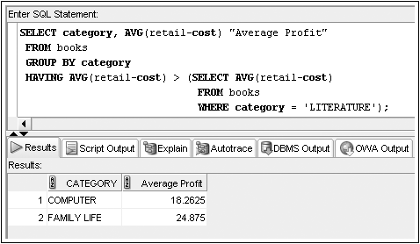
Single-Row Sub-Query in a SELECT Clause
- Replicates sub-query value for each row displayed
SELECT title, retail
(SELECT TO_CHAR(AVG(retail),999.99)
FROM books) "Overall Average"
FROM books;
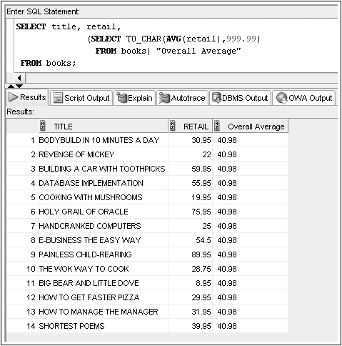
Multiple-Row Sub-Queries
- Return more than one row of results
- Require use of IN, ANY, ALL, or EXISTS operators
ANY and ALL Operators
- Combine with arithmetic operators
| Operator | Description |
|---|---|
>ALL |
More than the highest value returned by the sub-query |
<ALL |
Less than the lowest value returned by the sub-query |
<ANY |
Less than the highest value returned by the sub-query |
>ANY |
More than the lowest value returned by the sub-query |
=ANY |
Equal to any value returned by the sub-query (same as IN) |
Multiple-Row Sub-Query in a WHERE Clause
SELECT title, retail, category
FROM books
WHERE retail IN (SELECT MAX(retail)
FROM books
GROUP BY category)
ORDER BY category;
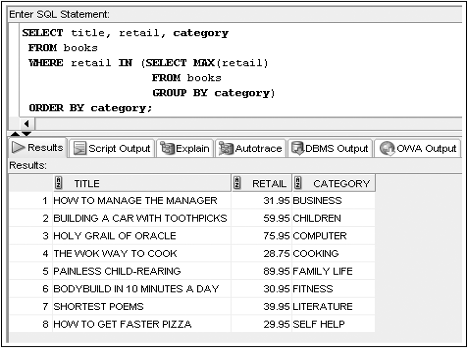
SELECT title, retail
FROM books
WHERE retail <ANY (SELECT retail
FROM books
WHERE category = 'COOKING');
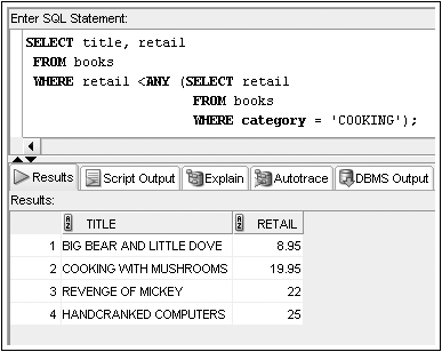
Multiple-Row Sub-Query in a HAVING Clause
SELECT order#, SUM(quantity*paideach)
FROM orderitems
HAVING SUM(quantity*paideach) >ALL (SELECT SUM(quantity*paideach)
FROM customers JOIN orders USING (customer#)
JOIN orderitems USING (order#)
WHERE state = 'FL'
GROUP BY order#)
GROUP BY order#;
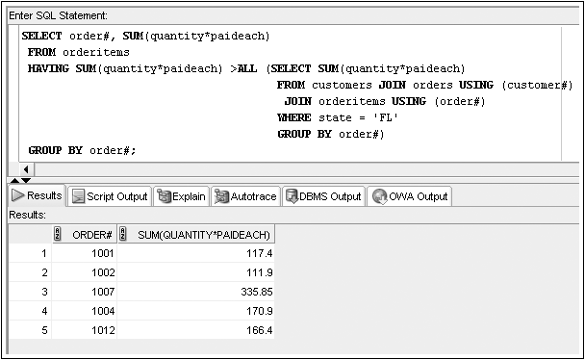
Multiple-Column Sub-Queries
- Return more than one column in results
- Can return more than one row
- Column list on the left side of operator must be in parentheses
- Use the IN operator for WHERE and HAVING clauses
Multiple-Column Sub-Query in a FROM Clause
- Creates a temporary table
SELECT b.title, b.retail, a.category, a.cataverage
FROM books b, (SELECT category, AVG(retail) cataverage
FROM books
GROUP BY category) a
WHERE b.category = a.category
AND b.retail > a.cataverage;
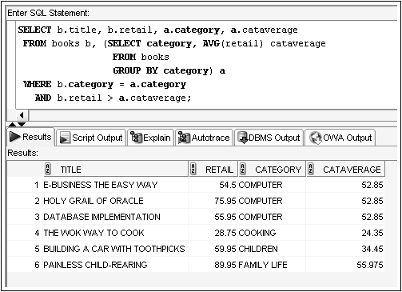
Multiple-Column Sub-Query in a WHERE Clause
- Returns multiple columns for evaluation
SELECT title, retail, category
FROM books
WHERE (category, retail) IN (SELECT category, MAX(retail)
FROM books
GROUP BY category)
ORDER BY category;
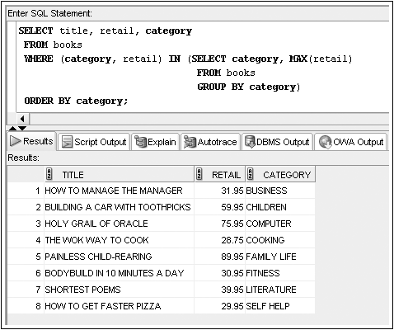
NULL Values
- When a sub-query might return NULL values, use NVL function
SELECT customer#
FROM customers
WHERE NVL(referred, 0) = (SELECT NVL(referred, 0)
FROM customers
WHERE customer# = 1005);
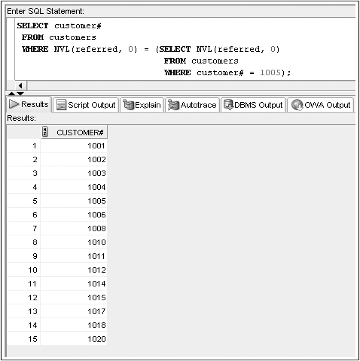
Uncorrelated Sub-Queries
-
- Processing sequence
-
- Inner query is executed first
-
- Result is passed to outer query
-
- Outer query is executed
Correlated Sub-Queries
- Inner query is executed once for each row processed by the outer query
- Inner query references the row contained in the outer query
SELECT title
FROM books
WHERE EXISTS (SELECT isbn
FROM orderitems
WHERE books.isbn = orderitems.isbn);
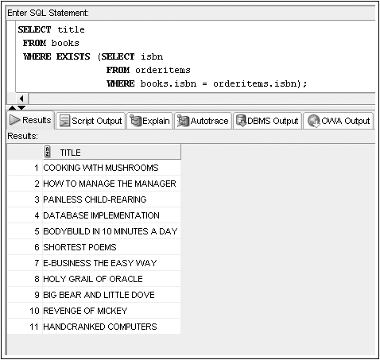
Nested Sub-Queries
- Maximum of 255 sub-queries if nested in the WHERE clause
- No limit if nested in the FROM clause
-
Innermost sub-query is resolved first, then the next level, etc
- Innermost is resolved first(A), then the second level(B), then the outer query(C)
SELECT customer#, lastname, firstname
FROM customers JOIN orders USING(customer#)
WHERE order# IN (SELECT order#
FROM orderitems
GROUP BY order#
HAVING COUNT(*) = (SELECT MAX(COUNT(*))
FROM orderitems
GROUP BY order#));
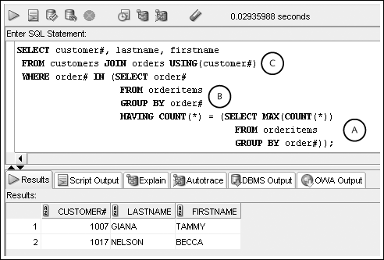
Sub-Query Factoring Clause
WITH dcount AS (
SELECT deptno, COUNT(*) AS dcount
FROM employees
GROUP BY deptno)
SELECT e.lname Emp_Lastname,
e.deptno e_dept,
d1.dcount edept_count,
m.lname manager_name,
m.deptno mdept,
d2.dcount mdept_count
FROM employees e,
dcount d1,
employees m,
dcount d2
WHERE e.deptno = d1.deptno
AND e.mgr = m.empno
AND m.deptno = d2.deptno
AND e.mgr = '7839';
Sub-Query in a DML Action
UPDATE employees
SET bonus = (SELECT AVG(bonus)
FROM employees)
WHERE empno = 8844;
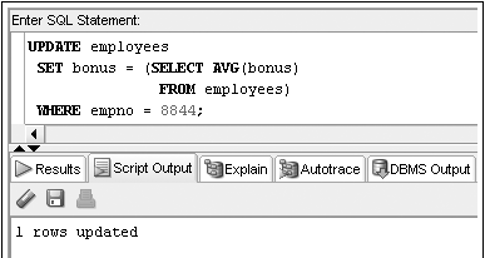
MERGE Statement
- With a MERGE statement, a series of DML actions can occur with a single SQL statement
- Conditionally updates one data source based on another
MERGE INTO books_1 a
USING books_2 b
ON (a.isbn = b.isbn)
WHEN MATCHED THEN
UPDATE SET a.retail = b.retail, a.category = b.category
WHEN NOT MATCHED THEN
INSERT (isbn, title, pubdate, retail, category)
VALUES (b.isbn, b.title, b.pubdate, b.retail, b.category);
SELECT * FROM books_1;
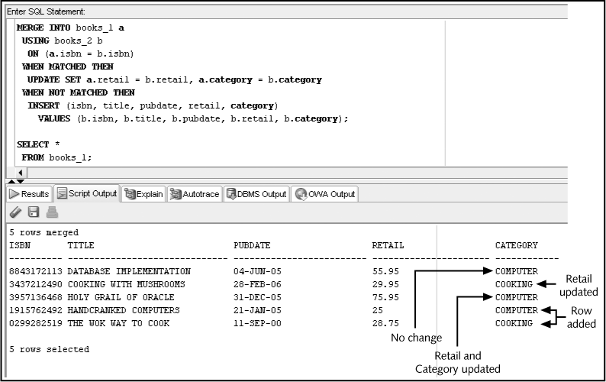
The following explains each part of the previous MERGE statement:
- MERGE INTO books_1 a: The BOOKS_1 table is to be changed and a table alias of “a” is assigned to this table
- USING books_2 b: The BOOKS_2 table will provide the data to update and/or insert into BOOKS_1 and a table alias of “b” is assigned to this table
- ON (a.isbn = b.isbn): The rows of the two tables will be joined or matched based on isbn
- WHEN MATCHED THEN: If a row match based on ISBN is discovered, execute the UPDATE action in this clause. The UPDATE action instructs the system to modify only two columns (Retail and Category)
- WHEN NOT MATCHED THEN: If no match is found based on the ISBN (a books exists in BOOKS_2 that is not in BOOKS_1), then perform the INSERT action in this clause
MERGE with WHERE
MERGE INTO books_1 a
USING books_2 b
ON (a.isbn = b.isbn)
WHEN MATCHED THEN
UPDATE SET a.retail = b.retail, a.category = b.category
WHERE b.category = 'COMPUTER'
WHEN NOT MATCHED THEN
INSERT (isbn, title, pubdate, retail, category)
VALUES (b.isbn, b.title, b.pubdate, b.retail, b.category)
WHERE b.category = 'COMPUTER';
SELECT * FROM books_1;
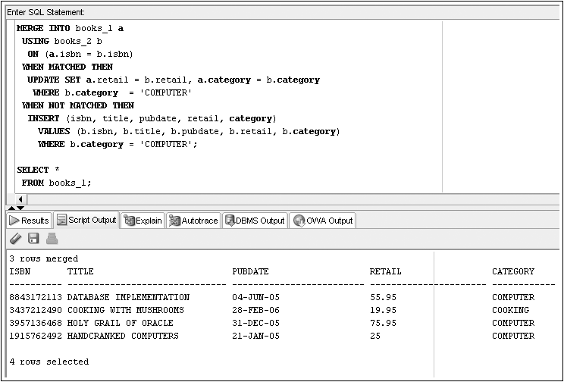
MERGE with DELETE
MERGE INTO books_1 a
USING books_2 b
ON (a.isbn = b.isbn)
WHEN MATCHED THEN
UPDATE SET a.retail = b.retail, a.category = b.category
DELETE WHERE (b.retail < 50);
SELECT * FROM books_1;
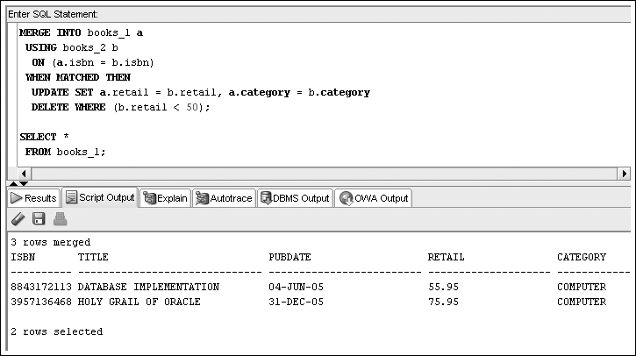
Summary
-
- A sub-query is a complete query nested in the SELECT, FROM, HAVING, or WHERE clause of another query
- The sub-query must be enclosed in parentheses and have a SELECT and a FROM clause, at a minimum
- Sub-queries are completed first; the result of the sub-query is used as input for the outer query
- A single-row sub-query can return a maximum of one value
- Single-row operators include =, >, <, >=, <=, and <>
- Multiple-row sub-queries return more than one row of results
- Operators that can be used with multiple-row sub-queries include IN, ALL, ANY, and EXISTS
- Multiple-column sub-queries return more than one column to the outer query
- NULL values returned by a multiple-row or multiple-column sub-query will not present a problem if the IN or =ANY operator is used
- Correlated sub-queries reference a column contained in the outer query
- Sub-queries can be nested to a maximum depth of 255 sub-queries in the WHERE clause of the parent query
- With nested sub-queries, the innermost sub-query is executed first, then the next highest level sub-query is executed, and so on, until the outermost query is reached
- A MERGE statement allows multiple DML actions to be conditionally performed while comparing data of two tables

Leave a comment